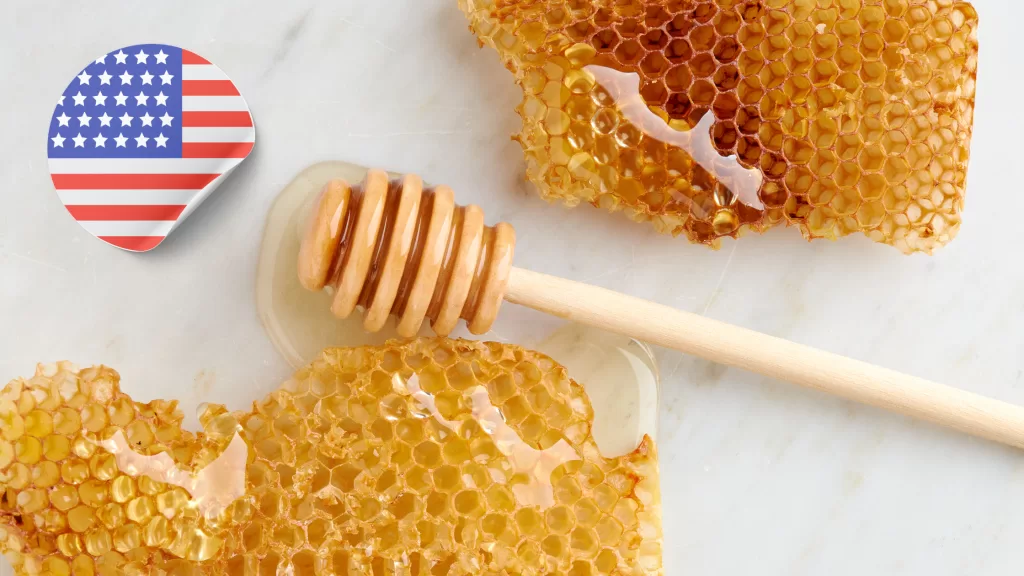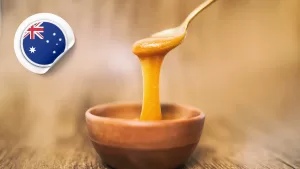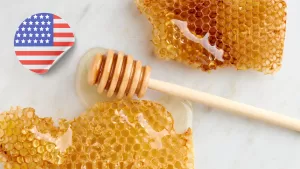Honey, one of nature’s sweetest treasures, has been an integral part of human diets and cultures for thousands of years. In the United States of America (USA), honey production is not only a thriving industry but also a testament to the country’s diverse ecosystems. From the tropical blossoms of Florida to the arid landscapes of the Southwest and the verdant hills of the Midwest, the variety of honey produced in the USA reflects the nation’s rich biodiversity. In this blog, we will explore the different types of honey found across the USA, delve into the honey production process, and uncover the benefits that make American honey so special.
Table of Contents
ToggleThe Importance of Honey in the USA
The United States is one of the world’s largest producers of honey, with millions of pounds harvested each year. Beekeeping, or apiculture, plays a vital role in the agriculture industry, contributing to the pollination of crops that are essential to food production. Honeybees, including both managed colonies and wild populations, are responsible for pollinating more than 90 commercial crops in the USA, from almonds and apples to blueberries and pumpkins.
Honey production in the USA varies significantly by region, and the flavor, color, and texture of honey are largely influenced by the local flora. Each region’s unique climate and plant life give rise to distinct types of honey, making American honey some of the most diverse and versatile in the world.
Types of Honey in the USA
Honey in the USA is categorized based on the flowers from which the nectar is collected. Each type of flower produces honey with a unique flavor profile, color, and texture. Let’s take a closer look at some of the most popular types of honey produced across the USA.
1. Clover Honey
Clover honey is the most common variety in the USA, making up a significant portion of commercial honey production. It has a mild, sweet flavor with a light golden hue. This honey is sourced from the nectar of clover plants, which are widespread across the country, particularly in the Midwest. Clover honey is a favorite for cooking, baking, and sweetening beverages due to its versatile and mild taste.
2. Wildflower Honey
Wildflower honey, often referred to as “multifloral honey,” is made from the nectar of various wildflowers. Its flavor can range from mild to robust, depending on the types of flowers in bloom. Because it is collected from different plants, wildflower honey can vary greatly by region and season. In the USA, this honey is popular in areas like Texas and the Southeast, where wildflowers flourish.
3. Orange Blossom Honey
Orange blossom honey is produced in regions where citrus groves dominate, such as Florida, California, and Texas. This honey has a light color and a sweet, fruity flavor that reflects the citrus flowers from which it’s made. Orange blossom honey is prized for its delicate aroma and is often used in gourmet cooking and desserts.
4. Alfalfa Honey
Alfalfa honey comes from the nectar of alfalfa flowers, which are commonly found in states like Montana, North Dakota, and California. It has a light color and a mild, slightly floral taste. Alfalfa honey is often used in baking and as a sweetener for beverages due to its subtle flavor profile.
5. Tupelo Honey
Tupelo honey is a rare and highly sought-after variety produced in the swamps of the southeastern USA, particularly in Georgia and Florida. The nectar is collected from the white tupelo tree, and the honey has a light golden hue with a distinctive, buttery flavor. Tupelo honey does not crystallize easily, making it a popular choice for those who prefer liquid honey. Due to its limited availability, it is considered one of the finest honeys in the world.
6. Buckwheat Honey
Buckwheat honey is known for its dark color and bold, malty flavor. Produced primarily in the northern states like New York, Ohio, and Pennsylvania, as well as parts of the Midwest, buckwheat honey is rich in antioxidants and has a robust, earthy taste. Its strong flavor makes it ideal for pairing with savory dishes or using in marinades and sauces.
7. Sage Honey
Sage honey is primarily produced in California, where the climate and landscape are ideal for sage plants. It has a light, delicate flavor with a hint of herbal undertones. Sage honey is known for its slow crystallization process, making it a popular choice for long-term storage.
8. Avocado Honey
Avocado honey is sourced from the nectar of avocado blossoms, mainly in California. This honey is dark in color and has a rich, buttery taste, which pairs well with savory dishes. It is less common than other types of honey but is beloved by food enthusiasts for its unique flavor.
The Honey Production Process in the USA
Honey production in the USA involves a complex process that begins with honeybees collecting nectar from flowers. Beekeepers manage colonies of honeybees, ensuring that the bees have access to healthy environments where they can thrive and produce honey.
Here’s a brief overview of the honey production process:
- Nectar Collection: Honeybees collect nectar from flowers using their long, tube-like tongues. The nectar is stored in their “honey stomach,” where enzymes begin to break down the sugars.
- Honeycomb Storage: Once the bees return to the hive, they regurgitate the nectar into hexagonal cells made of beeswax. The bees then fan their wings to evaporate the water content from the nectar, thickening it into honey.
- Capping the Honey: Once the honey has reached the desired consistency, the bees seal the honeycomb cells with beeswax to preserve the honey for future use.
- Harvesting: Beekeepers carefully remove frames of honeycomb from the hive and extract the honey using a centrifuge or other methods. The honey is then filtered and bottled for sale.
- Bottling and Distribution: After extraction, the honey is often filtered to remove any impurities and bottled for commercial or local distribution.
The Benefits of Honey
Honey is more than just a natural sweetener. It offers a host of health benefits, making it a staple in both households and wellness communities. Here are some of the top benefits of consuming honey:
1. Rich in Antioxidants
Honey, particularly darker varieties like buckwheat honey, is packed with antioxidants, which help protect the body from cell damage caused by free radicals. Antioxidants are important for reducing inflammation, supporting heart health, and protecting against chronic diseases.
2. Antibacterial and Antifungal Properties
Honey has natural antibacterial and antifungal properties, making it an effective remedy for minor wounds, burns, and skin infections. Raw honey contains hydrogen peroxide, which is responsible for these properties, and is often used in home remedies for its healing benefits.
3. Soothes Coughs and Sore Throats
One of honey’s most well-known benefits is its ability to soothe a sore throat and reduce coughing. A spoonful of honey, particularly when mixed with warm water and lemon, can help alleviate symptoms of a cold or respiratory infection.
4. Promotes Digestive Health
Honey has been used as a digestive aid for centuries. It contains prebiotics, which help nourish the good bacteria in the gut. Some types of honey, like Manuka honey, are particularly beneficial for digestive health, as they help reduce inflammation in the digestive tract.
5. Boosts Energy
Honey is a natural source of carbohydrates, which provide the body with a quick boost of energy. Athletes and fitness enthusiasts often use honey as a natural energy source during workouts or competitions.
Honey in the American Market
The USA has a thriving honey market, with both large commercial operations and small-scale beekeepers contributing to the industry. Local honey is highly valued by consumers, not only for its unique flavor profiles but also for its potential health benefits, such as alleviating seasonal allergies by exposing consumers to local pollen.
Farmers’ markets, specialty food stores, and online retailers offer a wide variety of honey, allowing consumers to explore the different types of honey produced in the USA. Many beekeepers also offer raw, unfiltered honey, which retains more of the natural enzymes, antioxidants, and other beneficial compounds found in honey straight from the hive.
The Future of Honey Production in the USA
While honey production in the USA continues to thrive, there are challenges facing the industry. The decline of honeybee populations due to factors such as habitat loss, pesticide use, and disease has raised concerns about the future of honey production and pollination services. Beekeepers across the country are working to combat these challenges by promoting sustainable beekeeping practices, advocating for pollinator-friendly policies, and raising awareness about the importance of honeybees in the ecosystem.
Conclusion: The Sweet Legacy of USA Honey
Honey is more than just a sweet treat—it’s a reflection of the rich and varied landscapes of the United States. Each jar of honey tells a story of the local flora, the hardworking bees that produced it, and the dedicated beekeepers who harvested it. Whether you prefer the light, delicate flavor of clover honey or the bold, robust taste of buckwheat honey, there’s a type of honey in the USA for every palate.
As consumers become more interested in sustainable and local food sources, the demand for American honey continues to grow. By supporting local beekeepers and choosing USA-produced honey, we can help ensure that honeybees remain a vital part of our ecosystems for generations to come.



